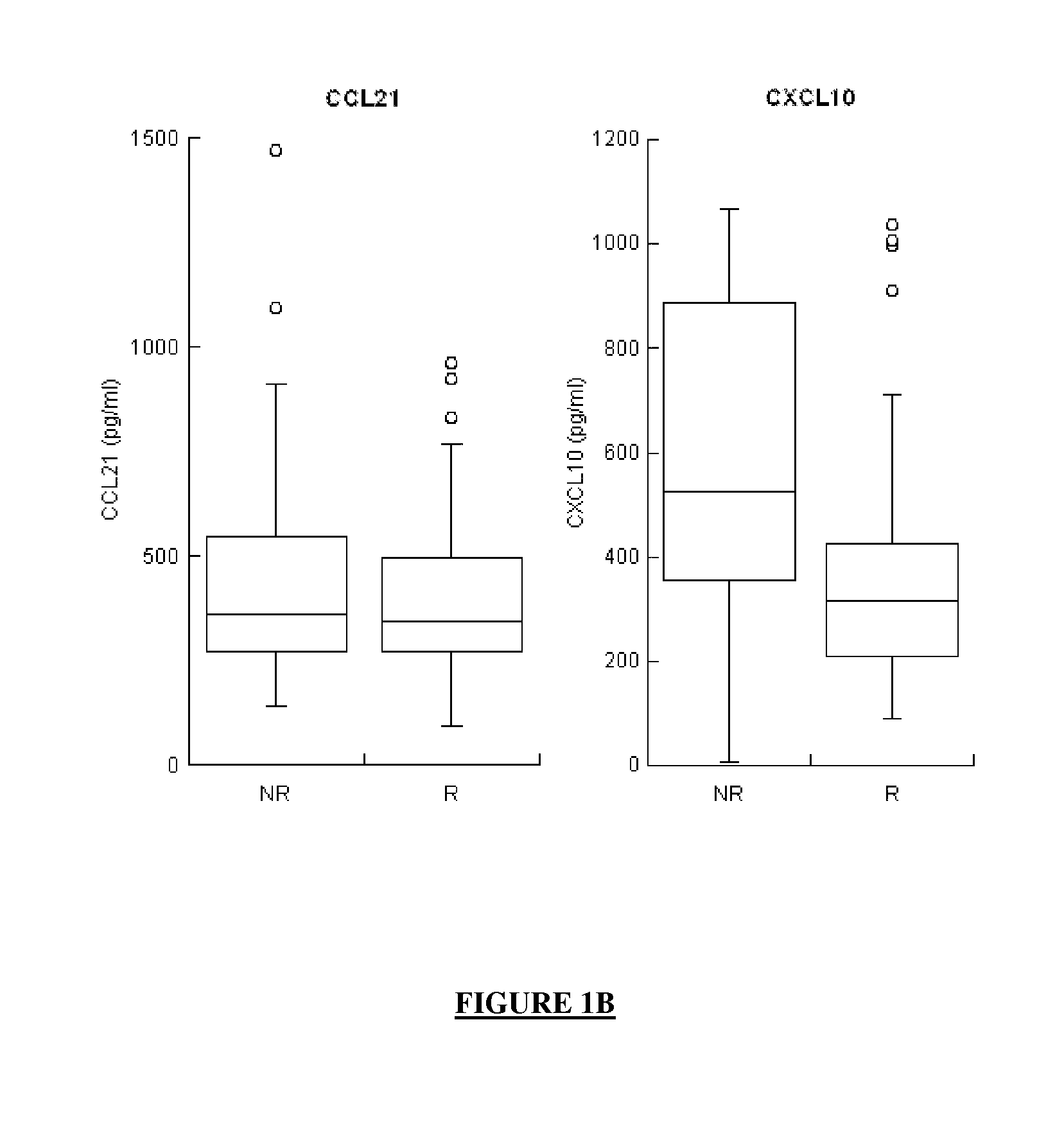Combination of biomarkers for the prognosis of response or non-response to an Anti-hcv treatment
a technology of anti-hcv and biomarkers, which is applied in the field of combination of biomarkers for the prognosis of response or non-response to an anti-hcv treatment, can solve the problems of asthenia, weight loss, sleep problems, and major side effects of patients
- Summary
- Abstract
- Description
- Claims
- Application Information
AI Technical Summary
Benefits of technology
Problems solved by technology
Method used
Image
Examples
example 1
Construction of Classification Models
1. Populations and Patients, Measurement of the Level of Gene Expression, Determination of Response to Treatment:
[0673]The study was approved by the local Ethics Committee in accordance with the Helsinki Declaration and all of the patients gave their informed written consent.
Presentation of Patients
[0674]The patients were adult patients infected with the hepatitis C virus (HCV), monitored at the Hôpital Beaujon (Clichy, France).
[0675]The clinical diagnosis of infection with the hepatitis C virus of the selected patients was established on the basis of the detection of antibodies directed against HCV proteins and the detection of circulating HCV RNA.
[0676]The serology of the HCV to be detected was carried out using the 3rd generation Abbott test (AxSYM™ HCV Version 3.0 (Abbott) Technique MEIA; index >1=positive; index <1=negative) and the VERSANT® HCV-RNA 3.0 (bDNA) ASSAY HCV RNA quantification test from Siemens Healthcare Diagnostics (quantificat...
example 2
RNA from Hepatic Biopsy Puncture (HBP) / Applications to Test Patients
2a) Example of Application of the Combination of the Levels of Expression (RNA) of the Genes MBL2, G1P2, LGALS3BP, TGFB2 and CRP (Combination No. 1 in Table 12 Above):
[0823]Using the WKNN method (see Example 1 above), the LOOCV error associated with the combination of the levels of transcription (RNA) of the genes MBL2, G1P2, LGALS3BP, TGFB2 and CRP (combination No. 1 in Table 12 above) is 12 (see Table 13 above).
[0824]The best performances for this combination using the WKNN method (computed over the population of responders (R) and non-responders (NR) of Example 1 (n=107 patients; see Table 33 above)) are as follows:
sensitivity (Se)=82%; specificity (Sp)=92% (see Table 13 above).
[0825]The model parameters used for the WKNN method were as follows:
Kernel (K): biweight
Parameter of Minkowski distance (D): 2
Number of neighbours (k): 3
[0826]Using this model, 71% of responder-relapsers (RR) were classified as responders ...
example 3
Seric Proteins (Combination of the Levels of Expression of 5 Genes)
[0857]The levels of expression of the proteins CXCL10, LGALS3BP, IL8, CCL21 and MDK (combination No. 24 in Table 12 above) were measured in the serum of 167 patients. Protein measurements were carried out as described in Example 1 and Table 44 above.
[0858]This group of 167 patients was constituted as follows:[0859]67 patients, for whom a serum sample was available, were selected using the same inclusion and exclusion criteria as the 140 patients described in Table 30 above and were added to this group of 140 patients;[0860]From among the 207 patients thus collected together, patients responding to treatment (status R) or patients not responding to treatment (status NR) were selected for whom all clinical, biological and virological data were available,
which resulted in a group of 167 patients (see Table 45 above).
[0861]From among these 167 patients:[0862]90 of them were shown to be responders to treatment (status R);...
PUM
| Property | Measurement | Unit |
|---|---|---|
| Fraction | aaaaa | aaaaa |
| Fraction | aaaaa | aaaaa |
| Fraction | aaaaa | aaaaa |
Abstract
Description
Claims
Application Information
 Login to View More
Login to View More - R&D
- Intellectual Property
- Life Sciences
- Materials
- Tech Scout
- Unparalleled Data Quality
- Higher Quality Content
- 60% Fewer Hallucinations
Browse by: Latest US Patents, China's latest patents, Technical Efficacy Thesaurus, Application Domain, Technology Topic, Popular Technical Reports.
© 2025 PatSnap. All rights reserved.Legal|Privacy policy|Modern Slavery Act Transparency Statement|Sitemap|About US| Contact US: help@patsnap.com



